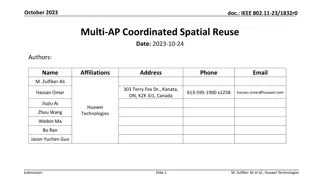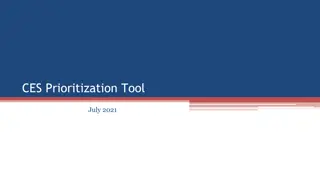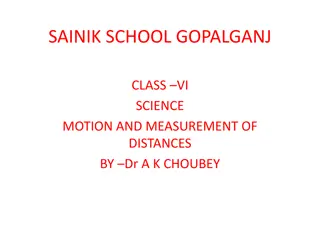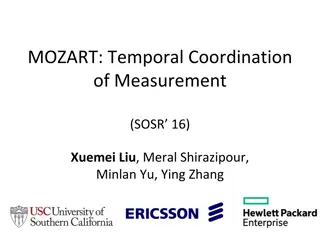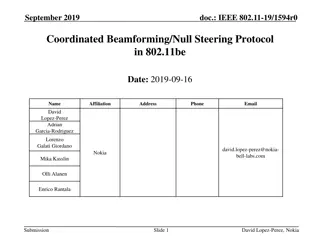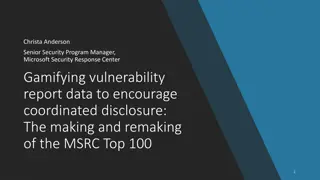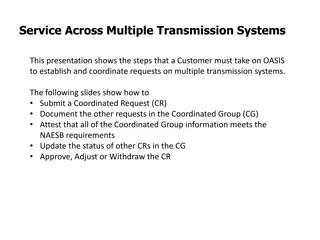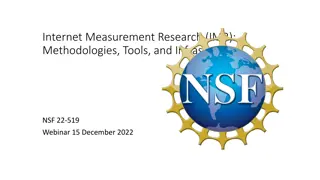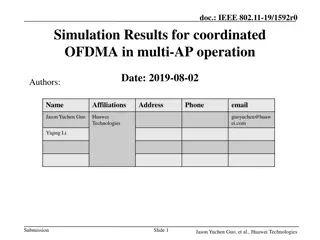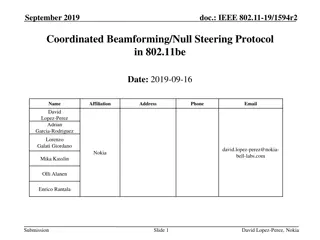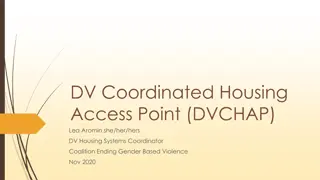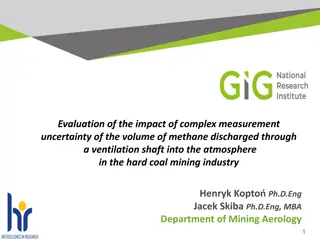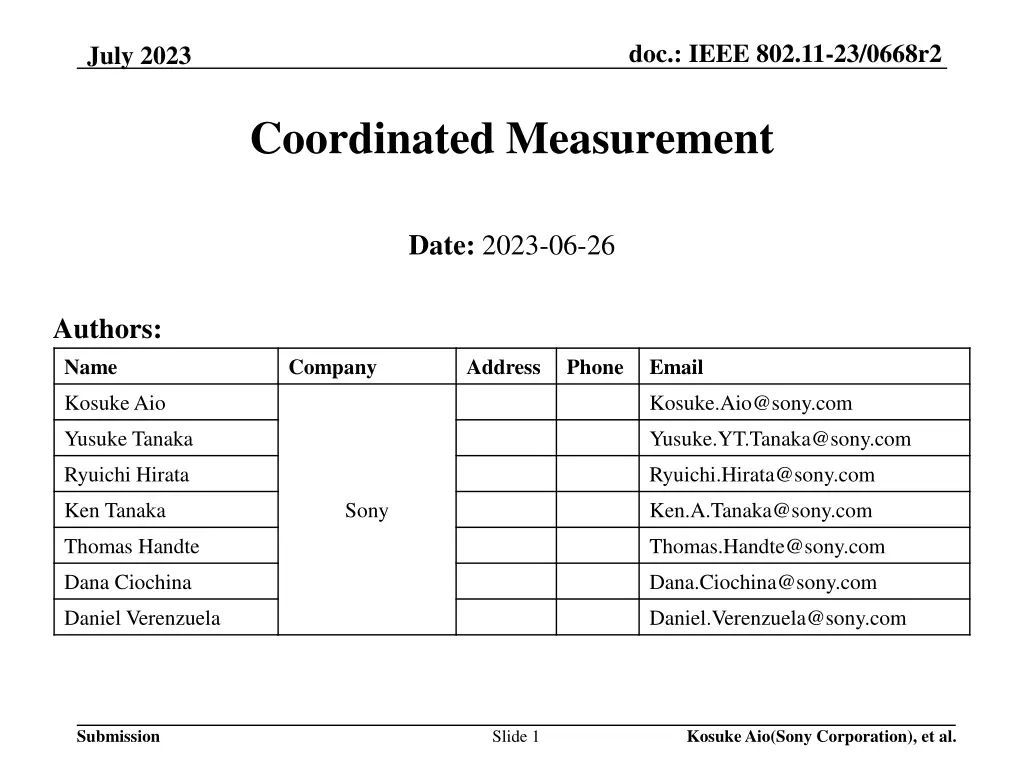
Coordinated Measurement Schemes for IEEE 802.11-23/0668r2
Enhance link quality in overlapping BSS scenarios with coordinated measurement schemes proposed in IEEE 802.11-23/0668r2. Explore how Coordinated Spatial Reuse, Seamless Roaming, and Coordinated R-TWT benefit from efficient data collection through coordinated measurements. Learn about the existing measurement challenges and the proposal for more effective OBSS signal measurements.
Download Presentation

Please find below an Image/Link to download the presentation.
The content on the website is provided AS IS for your information and personal use only. It may not be sold, licensed, or shared on other websites without obtaining consent from the author. If you encounter any issues during the download, it is possible that the publisher has removed the file from their server.
You are allowed to download the files provided on this website for personal or commercial use, subject to the condition that they are used lawfully. All files are the property of their respective owners.
The content on the website is provided AS IS for your information and personal use only. It may not be sold, licensed, or shared on other websites without obtaining consent from the author.
E N D
Presentation Transcript
doc.: IEEE 802.11-23/0668r2 July 2023 Coordinated Measurement Date: 2023-06-26 Authors: Name Company Address Phone Email Kosuke Aio Kosuke.Aio@sony.com Yusuke Tanaka Yusuke.YT.Tanaka@sony.com Ryuichi Hirata Ryuichi.Hirata@sony.com Ken Tanaka Sony Ken.A.Tanaka@sony.com Thomas Handte Thomas.Handte@sony.com Dana Ciochina Dana.Ciochina@sony.com Daniel Verenzuela Daniel.Verenzuela@sony.com Submission Kosuke Aio(Sony Corporation), et al. Slide 1
doc.: IEEE 802.11-23/0668r2 July 2023 Introduction Scenario of overlapping BSS scenario is TGbn PAR scope [1]. Some features need to measure link quality (such as RSSI/SNR) among multiple BSSs. For example, Coordinated Spatial Reuse can improve system throughput and latency by using RSSI/SNR between STA and OBSS APs to calculate the appropriate Tx power for multiple APs [2]. Seamless Roaming can maintain good link quality without interruption of data transmission by performing appropriate transitions using RSSI/SNR between STA and OBSS APs [3]. Coordinated R-TWT can protect emergency data communication with STA which observes high interference from OBSS AP/STA [4]. In this contribution, we propose coordinated measurement schemes to collect all the necessary information for the above features in a short time. Submission Kosuke Aio(Sony Corporation), et al. Slide 2
doc.: IEEE 802.11-23/0668r2 July 2023 Existing Measurement for OBSS Signal AP can request intra-BSS STAs to measure OBSS signal by Measurement Request/Response . Measurement Request/Response mechanism defined in IEEE 802.11 allows APs to request intra-BSS STAs to measure OBSS signal. General Procedure 1. AP sends Measurement Request element to intra-BSS STAs 2. STA responses Measurement Report element to the AP Measuring Beacon frames is typically used for RSSI measurement because the Tx power is relatively static compered to other frames. OBSS STA1 1. Measurement Request STA1 OBSS AP1 2. Measure OBSS Signal AP1 OBSS AP2 3. Measurement Report OBSS STA2 Submission Kosuke Aio(Sony Corporation), et al. Slide 3
doc.: IEEE 802.11-23/0668r2 July 2023 Problem of Existing Measurement Regardless of measurement type (active/passive), it typically takes more than 100-200ms to complete the measurement process. For passive measurement, Beacon interval is usually set to 100-200ms. For active measurement, STA allocate approximately 100-200ms to collect probe responses from all APs. In cases where a STA fails receiving Beacon from an OBSS AP for some reason, the measurement process will take even longer. Considering mobility scenario, a more efficient OBSS signal measurement scheme is required. For instance, when STAs are moving, there is a high likelihood that RSSI values will have significantly varied. Submission Kosuke Aio(Sony Corporation), et al. Slide 4
doc.: IEEE 802.11-23/0668r2 July 2023 Proposal We propose coordinated measurement schemes. Coordinated Measurement is the cooperative transmission/observation of test signals and sharing measurement results among multiple APs. By actively acquiring the OBSS signal, we can expect a significant reduction in measurement time. There are two types of coordinated measurement: Implicit and Explicit type Explicit Coordinated Measurement Implicit Coordinated Measurement (1) AP1 requests AP2/AP3 to measure STA1 s signal. (1) AP1 requests AP2/AP3 to send test signal. (2) STA1 sends UL signal byAP1 s trigger. (3) STA1 measures RSSI from AP2/AP3 1 and report it to AP1 (3) AP2/AP3 measure RSSI from STA1 and report it to AP1 (2) AP2/AP3 send test signal. Submission Kosuke Aio(Sony Corporation), et al. Slide 5
doc.: IEEE 802.11-23/0668r2 July 2023 Coordinated Measurement: Explicit Type Detail Procedure (reused 11ax Explicit BF Sounding Procedure) AP1 requests AP2/AP3 to send a test signal (e.g., NDP) and collect responses. AP1 sends a request frame (e.g., NDP-A) to request STAs to measure the signal from AP2/AP3. AP2/AP3 send the test signal sequentially (or simultaneously). The STAs measure RSSI/SNR of the test signals from AP2/AP3. AP1 sends a trigger frame (e.g., BFRP Trigger) to request the STAs to feedback the RSSI/SNR information in UL OFDMA. The STAs send the RSSI/SNR information to AP1. , Submission Kosuke Aio(Sony Corporation), et al. Slide 6
doc.: IEEE 802.11-23/0668r2 July 2023 Coordinated Measurement: Implicit Type Detail Procedure (reused 11ax NDP Feedback Report Procedure) AP1 requests AP2/AP3 to measure a test signal (e.g., HE TB feedback NDP) from STAs and collects responses. AP1 sends a trigger frame (e.g., NFRP Trigger) to request STAs to send the test signal. The STAs send the test signal. AP2 and AP3 measure RSSI/SNR of the test signals from the STAs. AP2 and AP3 report the RSSI/SNR information to AP1 (sequentially or simultaneously). , Submission Kosuke Aio(Sony Corporation), et al. Slide 7
doc.: IEEE 802.11-23/0668r2 July 2023 Evaluation Parameters The total duration of each coordinated measurement is calculated. Assumption 3APs are installed, and 1/2/4/16 STAs per BSS NDP and TB PPDU are HE PPDU in 80MHz. Others are non-HE PPDU in 20MHz. NDP includes 2xHE-LTF with 0.8us GI MCS 0 for all frames. Frame length/duration of the existing frames NDP-A: 21byte + 4byte per STA BFRP Trigger frame: 28byte + 6byte per STA NFRP Trigger frame: 33byte HE Sounding NDP: 47.2us HE TB feedback NDP: 56us Frame duration of the new defined frames Coordinated Measurement Request: Like 11ax Trigger frame MAC Header + Common field + FCS(28byte) + User Info(6byte) per OBSS AP Coordinated Measurement Response: MAC Header (20byte) + Flag (1byte) RSSI Info: MAC Header (20byte) + RSSI value (1byte) per link Submission Kosuke Aio(Sony Corporation), et al. Slide 8
doc.: IEEE 802.11-23/0668r2 July 2023 Comparison Results Coordinated v.s. Beacon Measurement (16STAs in a BSS) Explicit v.s. Implicit Whereas Beacon Measurement takes tens of ms, both types of Coordinated Measurement for each BSS are completed in 1ms even if there a lot of STAs. Submission Kosuke Aio(Sony Corporation), et al. Slide 9
doc.: IEEE 802.11-23/0668r2 July 2023 Further Consideration Points How to use Implicit/Explicit type? When considering RF impairments of transceiver/receiver can be ignored (as symmetric link), we can use whichever type we prefer. Otherwise, the measurement type should be selected based on the primary usage scenario For example, when APs intend to use Coordinated SR in DL, they should measure RSSI/SNR of interference links using the Explicit type. How to schedule Coordinated Measurement? Even if Sharing AP (AP obtaining TXOP) sends Coordination Measurement Requests, OBSS APs may not receive or may not be able to respond to the request due to other ongoing communications within the BSSs. To ensure effective Coordinated Measurement, it is advisable to pre-determine a service period by utilizing R-TWT or other means. This will help in coordinating the measurement process among the APs and mitigating potential conflicts with ongoing transmissions. Submission Kosuke Aio(Sony Corporation), et al. Slide 10
doc.: IEEE 802.11-23/0668r2 July 2023 Summary We proposed two coordinated measurement schemes to shorten measurement time. Implicit Coordinated Measurement Explicit Coordinated Measurement According to the evaluation, both schemes can shorten measurement time substantially. Both measurements were completed in 1ms. Implicit has a shorter measurement time, and the difference between Implicit and Explicit becomes larger as the number of STAs becomes larger. Submission Kosuke Aio(Sony Corporation), et al. Slide 11
doc.: IEEE 802.11-23/0668r2 July 2023 Reference [1] Laurent Cariou (Intel), UHR proposed PAR, 23/0480r0, March 2023 [2] Kosuke Aio (Sony Group Corporation), Recap on Coordinated Spatial Reuse Operation, 22/1822r0, November 2022. [3] Duncan Ho (Qualcomm), Seamless Roaming for UHR, 22/1910r1, January 2023 [4] SunHee Baek (LG Electronics), Coordinated R-TWT Protection in Multi- BSS, 23/0771r0, May 2023 Submission Kosuke Aio(Sony Corporation), et al. Slide 12
doc.: IEEE 802.11-23/0668r2 July 2023 SP Do you agree Coordinated Measurement as UHR/TGbn s feature? Coordinated Measurement is the cooperative procedure about transmission/observation of test signals and sharing measurement results among multiple APs. Yes No Abstain Submission Kosuke Aio(Sony Corporation), et al. Slide 13
doc.: IEEE 802.11-23/0668r2 July 2023 Appendix Simulation of RSSI measurement by HE TB feedback NDP Parameter Channel Model: TGac_D NLOS (Freq, BW) = (5180MHz, 20MHz) RSSI difference = Real RSSI Estimated RSSI Real RSSI is calculated from 252 subcarriers [-126:126] . Estimated RSSI is calculated from 6 subcarriers [-113,-77,-41,6,42,78]. Submission Kosuke Aio(Sony Corporation), et al. Slide 14

